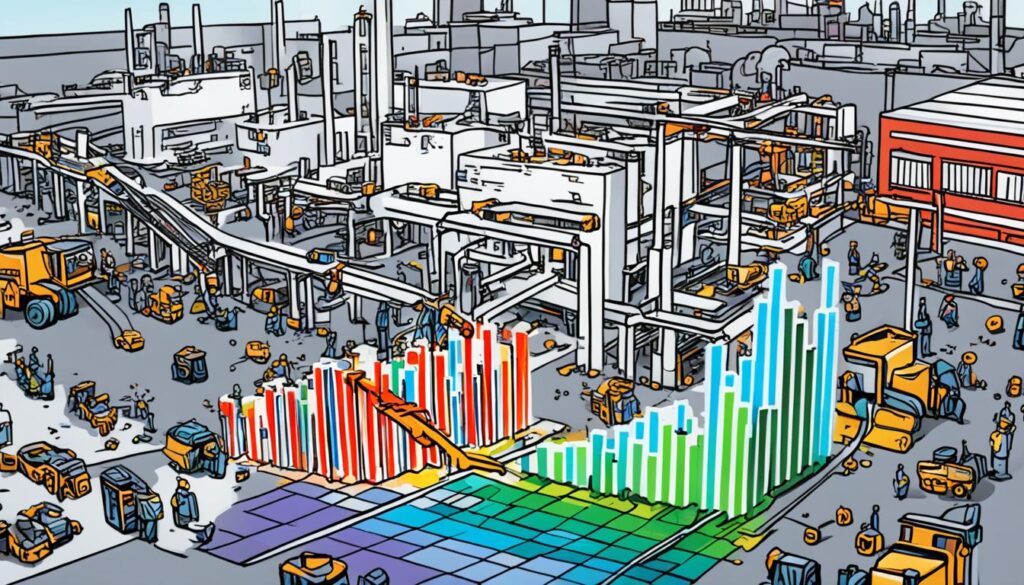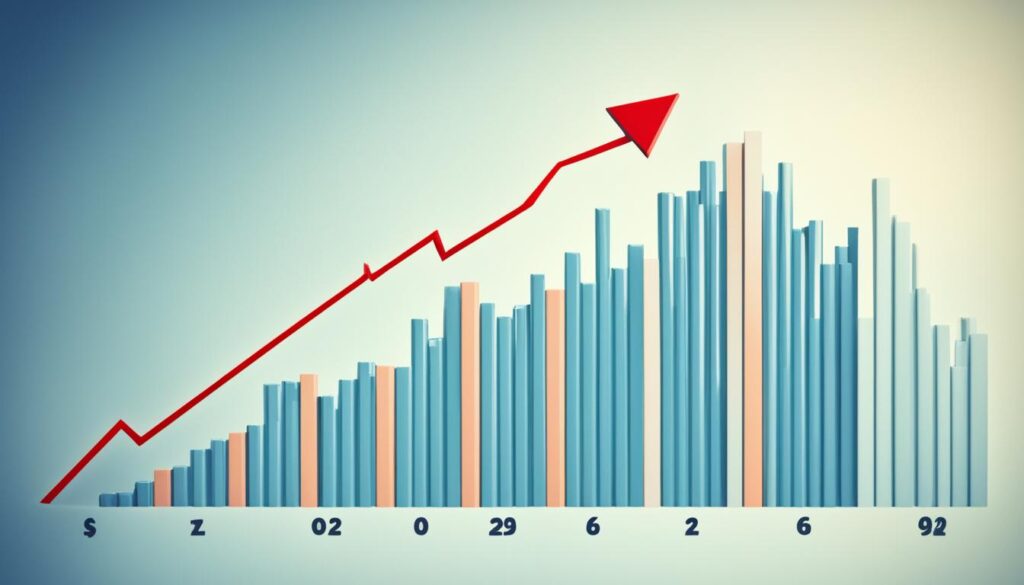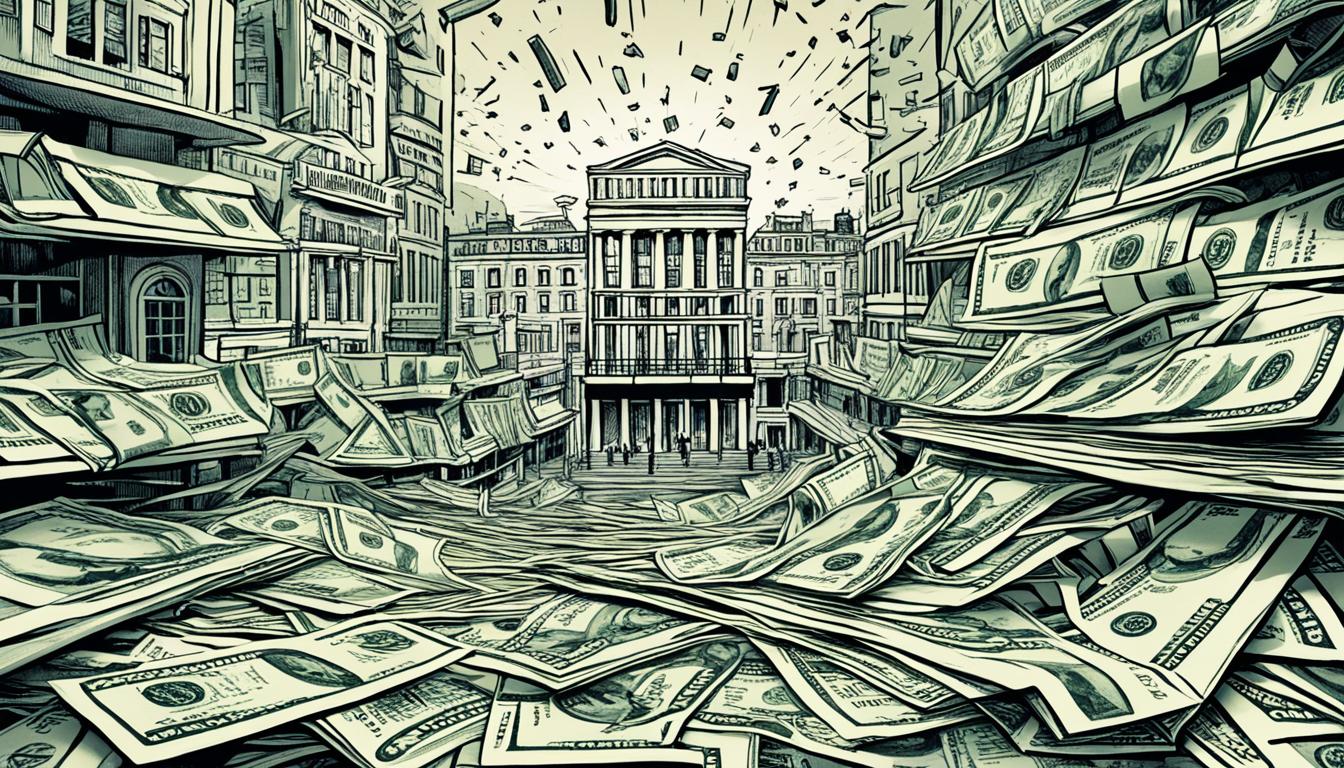“As an Amazon Associate I earn from qualifying purchases.”
Have you ever found yourself in a situation where your expenses seemed to outweigh your income? Perhaps you had to tighten your belt and cut back on non-essential spending until your financial situation improved. In many ways, a recession in the broader economy is similar – it’s a period when demand and production decrease, leading to an economic contraction characterized by declining consumer spending, business slowdowns, a rise in unemployment, and a GDP decline.
Key Takeaways
- Recessions involve a significant, widespread, and prolonged downturn in economic activity.
- They are marked by declining consumer spending, reduced business investment, rising unemployment, and a decrease in gross domestic product (GDP).
- Recessions can be caused by various factors, including supply chain disruptions, financial crises, housing market crashes, and mistimed fiscal or monetary policies.
- As demand for goods and services falls, companies may lay off workers, further reducing consumer spending power and exacerbating the economic slowdown.
- Understanding the root causes and dynamics of recessions is crucial for policymakers to develop effective strategies to mitigate their impact and facilitate economic recovery.
Understanding Recessions and Economic Contractions
A recession is an extended period of economic contraction characterized by a widespread decline in various economic indicators. It represents a significant prolonged downturn in economic activity, impacting both businesses and individuals.
Definition and Characteristics of a Recession
The National Bureau of Economic Research (NBER) officially defines a recession as a substantial decrease in economic activity across multiple sectors of the economy, lasting more than a few months. This recession definition encompasses a prolonged downturn marked by reduced industrial production, employment levels, real income, and wholesale-retail trade.
Measuring Recessions: GDP, Employment, and Other Indicators
To identify and measure recessions, economists rely on a range of economic indicators, including gross domestic product (GDP), employment rate, industrial production, real income, and retail sales data. The NBER evaluates the depth, duration, and diffusion of the economic contraction across various sectors.
While two consecutive quarters of negative GDP growth often serve as a rule of thumb for a recession, the NBER considers multiple factors beyond just GDP decline to determine the beginning and end of a recessionary period.
Here are some notable statistics that illustrate the prevalence and impact of recessions:
- Between 1960 and 2007, there were 122 recessions affecting 21 advanced economies, according to the International Monetary Fund (IMF).
- The U.S. has experienced 34 recessions since 1854, with only five occurring since 1980.
- During the Great Depression, U.S. economic output fell 33%, stocks plunged 80%, and unemployment hit 25%.
- On average, U.S. recessions since 1857 have lasted 17 months, with the six recessions since 1980 averaging under 10 months.
- The last U.S. recession began in 2020 due to the COVID-19 pandemic and ended after a record-short two-month duration.
Understanding the definition, characteristics, and measurement of recessions is crucial for policymakers, economists, and businesses to effectively navigate and mitigate the impacts of economic downturns.
Impact of Declining Demand on Economic Activity
During an economic recession, the declining demand for goods and services leads to reduced consumer spending and decreased business investment. As consumers become cautious about their finances and job prospects, they tend to cut back on discretionary spending, impacting various industries. Businesses, facing lower sales and revenue, may delay or cancel expansion plans, capital investments, and hiring, further contributing to the economic slowdown.
Reduced Consumer Spending and Business Investment
This vicious cycle of declining demand and production can reinforce itself, making it challenging to reverse the recessionary trend. As households tighten their budgets, spending on non-essential items, such as entertainment, travel, and luxury goods, often declines sharply. Businesses, in turn, respond by scaling back production, cutting costs, and postponing investments in new projects or expansion plans.
Ripple Effects on Employment and Income
The reduced demand for goods and services during a recession has ripple effects on employment and income levels. As businesses face lower sales and profits, they may lay off workers to cut costs, resulting in rising unemployment. Laid-off employees then have less disposable income, further decreasing consumer spending and exacerbating the economic downturn. This cycle of job losses, decreased income, and reduced spending can perpetuate the recessionary conditions, making it challenging for the economy to recover without intervention.

The table below illustrates the severity of some historical recessions and their impact on key economic indicators:
| Recession | GDP Decline | Unemployment Rate | Duration |
|---|---|---|---|
| Great Depression (1929-1939) | 33% | 25% | 10 years |
| Oil Crisis Recession (1973-1975) | 3.2% | 9% | 16 months |
| Great Recession (2007-2009) | 4.3% | 10% | 18 months |
| COVID-19 Recession (2020) | 3.5% | 14.7% | 2 months |
Supply Chain Disruptions and Production Slowdowns
Recessions can stem from supply shocks, such as supply chain disruptions or shortages of critical commodities. These supply-side issues lead to production slowdowns and output decline across various industries. If severe and widespread enough, supply shocks can trigger significant economic turmoil, reduced production levels, and price increases for businesses and consumers, ultimately contributing to a broader economic contraction.
Effects of Supply Shocks on Output and Prices
The impact of supply chain disruptions on output and prices has been evident in recent years. During the COVID-19 pandemic, manufacturers faced component shortages, leading to production cuts and higher costs for consumers. For instance, the semiconductor manufacturing industry saw increased demand following the pandemic that automakers had underestimated. Over 30,000 parts affect car prices due to the fragmented auto supply chain across many countries and firms.
These supply-side challenges were compounded by exogenous factors like the Russia-Ukraine war, which led to higher oil and gas prices and potential supply chain disruptions, further straining production and contributing to inflationary pressures.
While the history of supply disruptions in specific industries suggests that shortages are likely to be mostly transitory, the current supply-chain issues have been unprecedented. Indices of current delivery times are at record highs, indicating that it may take several months for these issues to abate, according to manufacturers’ expectations.
To address these challenges, the Biden-Harris Administration conducted a 100-day review of supply chains for critical products, including semiconductor manufacturing, advanced packaging, and large capacity batteries.
| Indicator | Value |
|---|---|
| U.S. Inflation in 2022 | ~6% |
| Inflation Rate as of Sept. 2023 | 3.7% |
| 2Q GDP Growth | 2.1% |
| Unemployment Rate (Sept. 2023) | 3.8% |
| Effective Federal Funds Rate (Oct. 2023) | 5.33% |
| Producer Price Index (May 2020 – May 2021) | +19% |
| Lumber Price Peak | $1,711 per thousand board-feet |
| Motor Vehicle Sector Contribution to Core Inflation | >50% (May CPI) |
Contractionary Fiscal and Monetary Policies
Governments and central banks have tools at their disposal that can inadvertently contribute to the development of a recession if implemented at the wrong time or to an excessive degree. These include contractionary fiscal policy measures, such as government spending cuts and tax increases, as well as contractionary monetary policy actions like interest rate hikes and money supply reduction.

Role of Government Spending and Taxation
Contractionary fiscal policies aim to reduce aggregate demand in the economy, but if enacted prematurely or excessively, they can trigger or exacerbate an economic downturn. Reduced government spending and higher taxes can lead to decreased consumer and business spending, further compounding the recessionary effects.
Interest Rate Adjustments and Money Supply
Central banks, like the Federal Reserve, can implement contractionary monetary policies to combat inflation or cool an overheating economy. These policies typically involve raising interest rates and reducing the money supply, making borrowing more expensive and limiting access to credit. While these measures can help control inflation, they can also lead to decreased lending, reduced investment, and lower consumer spending, potentially contributing to or exacerbating a recession if the timing or magnitude of the policy adjustments is misjudged.
which best describes how a recession develops as demand and production decrease?
During an economic downturn, a self-reinforcing cycle emerges, characterized by a feedback loop between declining demand and falling production. As consumer spending and business investment diminish, companies respond by scaling back operations and reducing output.
Feedback Loop of Declining Demand and Production
This initial drop in production leads to job losses, which further erodes consumer income and spending power, resulting in an even lower demand for goods and services. This vicious cycle of declining demand and falling production can perpetuate the economic contraction, making it increasingly difficult for the economy to recover without external interventions or policy measures.
Self-Reinforcing Cycle of Economic Contraction
As businesses grapple with lower sales and profits, they may resort to cost-cutting measures, including reducing employment. The resulting job losses translate into diminished consumer income and spending power, leading to further reductions in demand, production, and employment. This compounding effect can create a recessionary spiral that is challenging to break without targeted policy interventions or a favorable shift in economic conditions.
| Year | Recession Period | Peak Unemployment Rate |
|---|---|---|
| Mid-1970s | Recession | 5.5% |
| 1982-1983 | Recession | 10.5% |
| Early 1990s | Recession | High Interest Rates |
The table illustrates how past recessions in Australia were accompanied by significant increases in unemployment rates and, in the case of the early 1990s, a sharp rise in interest rates to combat inflation and speculative behavior in the property market.
Financial Market Turmoil and Credit Crunches
Financial crises have the potential to wreak economic turmoil, contributing to recessions and hampering economic growth. During such periods of financial crises, credit markets can freeze up, leading to a credit crunch that restricts access to financing for businesses and consumers alike.
Impact of Financial Crises on Economic Activity
When financial crises strike, they can have severe consequences on economic activity. A credit crunch ensues, making it difficult for businesses and individuals to secure loans or financing. This lack of access to credit can lead to decreased investment, reduced consumer spending, and ultimately, a slowdown in economic growth. Moreover, financial market turmoil can erode consumer and business confidence, further exacerbating the economic downturn.

Tightening Credit Conditions and Reduced Lending
During periods of financial market turmoil, lending institutions tend to tighten their credit standards and restrict access to financing. This tightening of credit conditions can limit the ability of businesses to invest in new projects or expansion plans, while also constraining consumer borrowing for big-ticket purchases like homes or vehicles. The resulting reduction in lending and investment can contribute to a slowdown in economic activity and potentially trigger or deepen a recession.
Historical examples of financial crises and their impact on lending and investment include:
- The Stock Crash of 1929, which saw a 89% decline in the Dow Jones Industrial Average, leading to the Great Depression.
- The 2007-2008 Global Financial Crisis, during which the Dow Jones Industrial Average lost 54% of its value.
- The COVID-19 pandemic, which caused a 34% drop in the S&P 500 between February 20 and March 23, 2020, before rebounding 28% by early April.
| Financial Crisis | Asset Price Decline | Lending Impact |
|---|---|---|
| Stock Crash of 1929 | 89% decline in Dow Jones Industrial Average | Significant credit crunch, leading to the Great Depression |
| 2007-2008 Global Financial Crisis | 54% loss in Dow Jones Industrial Average | Tightening of credit standards, reduced lending to businesses and consumers |
| COVID-19 Pandemic (2020) | 34% drop in S&P 500 (February 20 – March 23), followed by 28% rebound by early April | Temporary liquidity constraints and reduced lending |
In the aftermath of the 2008 Global Financial Crisis, the Dodd-Frank Wall Street Reform and Consumer Protection Act aimed to introduce financial regulatory reforms to prevent future crises and strengthen oversight of lending practices.
Housing Market Downturns and Wealth Effects
The housing market plays a pivotal role in the development of recessions due to the wealth effects associated with changes in home prices. When housing market downturns occur and home prices decline, homeowners may experience negative equity, where the value of their home is less than the outstanding mortgage balance. This reduction in household wealth can lead to decreased consumer spending, as individuals feel less financially secure.
Relationship Between Housing Prices and Recessions
Housing market dynamics have a strong relationship with economic cycles, and falling home prices can be both a cause and an effect of recessions. When housing prices drop, it can trigger a wealth effect that leads to reduced consumer spending, further exacerbating the economic downturn. Conversely, during recessions, job losses and tighter lending conditions can contribute to declining demand for housing, putting downward pressure on home prices.
Impact on Consumer Spending and Confidence
Declining housing prices and the associated wealth effect can have a significant impact on consumer spending and confidence. As homeowners experience a reduction in their net worth due to falling home values, they may feel less financially secure and become more cautious with their spending. This decrease in consumer spending can contribute to a broader economic slowdown, as consumer demand is a major driver of economic growth. Additionally, the erosion of consumer confidence during a housing market downturn can further exacerbate the recessionary conditions.
According to the International Monetary Fund, the 2008 global financial crisis and the double-dip slumps of the early 1980s were the worst recessions since the Great Depression and the 1937-38 recession.
Moreover, housing market downturns can have ripple effects on related industries, such as construction and real estate, further exacerbating the economic downturn. When home sales and prices decline, it can lead to a slowdown in construction activity, job losses in the construction sector, and reduced demand for related goods and services, compounding the recessionary pressures.
Historical Recessions and Policy Responses
Examining historical recessions provides valuable lessons for policymakers and economists on how to better respond to future economic downturns. Events like the Great Depression, the oil crisis-induced recession of the 1970s, and the Great Recession offer insights into the causes, consequences, and potential policy responses to mitigate the impact of recessions.
Lessons from Previous Economic Downturns
Historical recessions have underscored the importance of timely and effective policy interventions. For instance, the failure to implement robust countercyclical measures during the Great Depression exacerbated and prolonged the economic downturn. However, the aggressive fiscal stimulus and monetary easing measures implemented during the Great Recession helped to stabilize financial markets and support economic recovery.
Countercyclical Policies and Recovery Measures
To address recessions and stimulate economic recovery, governments and central banks often implement countercyclical policies aimed at boosting aggregate demand. These may include fiscal stimulus measures like tax cuts or increased government spending, as well as monetary easing through lower interest rates or quantitative easing.
Additionally, targeted recovery efforts like job creation programs, infrastructure investments, or industry-specific support can address specific economic weaknesses and facilitate a more robust and sustainable recovery.
| Recession Period | Key Factors | Policy Responses |
|---|---|---|
| Mid-1970s | Global oil price shock, increased production costs, reduced demand | Monetary tightening to control inflation (peaked at 18%), leading to recession |
| 1982-1983 | Entrenched high inflation globally, central bank tightening | Tighter monetary policies to reduce inflation (unemployment peaked at 10.5%) |
| Early 1990s | Excess domestic demand, property market speculation, high inflation | Interest rate hikes to curb inflation and demand, compounding global recession effects |
By learning from historical recessions and implementing appropriate policy responses, governments and central banks can potentially shorten the duration and severity of economic contractions, promoting long-term stability and growth.
Conclusion
In the wake of an economic downturn, understanding the root causes and dynamics of recessions is crucial for developing effective strategies to mitigate their impact and facilitate a robust recovery. Recessions are characterized by a significant and widespread decline in economic activity, marked by decreasing consumer spending, business slowdowns, rising unemployment, and a contraction in gross domestic product. These economic downturns can stem from various factors, including supply chain disruptions, financial crises, contractionary fiscal and monetary policies, housing market crashes, and self-reinforcing feedback loops between declining demand and production.
By learning from historical recessions and implementing countercyclical policies, governments and central banks can potentially shorten the duration and severity of economic contractions, promoting long-term economic stability and growth. Policy implications and future outlook for addressing recessions often involve fiscal measures, such as tax cuts or increased government spending, as well as monetary policies like lowering interest rates or injecting liquidity into the financial system through quantitative easing. Additionally, targeted recovery measures, such as job creation programs, infrastructure investments, or industry-specific support, may be implemented to address specific areas of economic weakness and facilitate a more robust and sustainable economic downturn summary.
Ultimately, understanding the root causes, policy implications, and future outlook of recessions is vital for policymakers and economists to develop effective strategies to mitigate their impact and promote economic recovery. By learning from historical economic downturns and implementing countercyclical policies, governments and central banks can potentially shorten the duration and severity of recessions, fostering long-term economic stability and growth for the future.
FAQ
What is a recession?
How are recessions measured?
What is the impact of declining demand on economic activity during a recession?
How can supply chain disruptions contribute to a recession?
How can contractionary fiscal and monetary policies affect the economy?
which best describes how a recession develops as demand and production decrease?
How can financial market turmoil contribute to a recession?
What is the relationship between housing market downturns and recessions?
What lessons can be learned from historical recessions?
“As an Amazon Associate I earn from qualifying purchases.”

